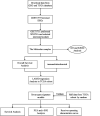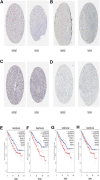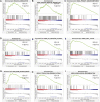Development and Validation of a Prognostic Gene Signature in Clear Cell Renal Cell Carcinoma
- PMID: 33968978
- PMCID: PMC8098777
- DOI: 10.3389/fmolb.2021.609865
Development and Validation of a Prognostic Gene Signature in Clear Cell Renal Cell Carcinoma
Abstract
Clear cell renal cell carcinoma (ccRCC), one of the most common urologic cancer types, has a relatively good prognosis. However, clinical diagnoses are mostly done during the medium or late stages, when mortality and recurrence rates are quite high. Therefore, it is important to perform real-time information tracking and dynamic prognosis analysis for these patients. We downloaded the RNA-seq data and corresponding clinical information of ccRCC from The Cancer Genome Atlas (TCGA) and Gene Expression Omnibus (GEO) databases. A total of 3,238 differentially expressed genes were identified between normal and ccRCC tissues. Through a series of Weighted Gene Co-expression Network, overall survival, immunohistochemical and the least absolute shrinkage selection operator (LASSO) analyses, seven prognosis-associated genes (AURKB, FOXM1, PTTG1, TOP2A, TACC3, CCNA2, and MELK) were screened. Their risk score signature was then constructed. Survival analysis showed that high-risk scores exhibited significantly worse overall survival outcomes than low-risk patients. Accuracy of this prognostic signature was confirmed by the receiver operating characteristic curve and was further validated using another cohort. Gene set enrichment analysis showed that some cancer-associated phenotypes were significantly prevalent in the high-risk group. Overall, these findings prove that this risk model can potentially improve individualized diagnostic and therapeutic strategies.
Keywords: WGCNA; kidney cancer; microarray; novel markers; prognostic model; targeting therapy.
Copyright © 2021 Zhan, Wang, Xu, Huang, Su, Chen, Wang, Qi and Bai.
Conflict of interest statement
The authors declare that the research was conducted in the absence of any commercial or financial relationships that could be construed as a potential conflict of interest.
Figures











Similar articles
-
Construction of Competitive Endogenous RNA Network and Verification of 3-Key LncRNA Signature Associated With Distant Metastasis and Poor Prognosis in Patients With Clear Cell Renal Cell Carcinoma.Front Oncol. 2021 Mar 24;11:640150. doi: 10.3389/fonc.2021.640150. eCollection 2021. Front Oncol. 2021. PMID: 33869028 Free PMC article.
-
Construction and Validation of an Autophagy-Related Prognostic Risk Signature for Survival Predicting in Clear Cell Renal Cell Carcinoma Patients.Front Oncol. 2020 May 5;10:707. doi: 10.3389/fonc.2020.00707. eCollection 2020. Front Oncol. 2020. PMID: 32432045 Free PMC article.
-
Construction of a novel immune response prediction signature to predict the efficacy of immune checkpoint inhibitors in clear cell renal cell carcinoma patients.Heliyon. 2023 May 25;9(6):e15925. doi: 10.1016/j.heliyon.2023.e15925. eCollection 2023 Jun. Heliyon. 2023. PMID: 37484396 Free PMC article.
-
Identification of a three-miRNA signature as a novel potential prognostic biomarker in patients with clear cell renal cell carcinoma.J Cell Biochem. 2019 Aug;120(8):13751-13764. doi: 10.1002/jcb.28648. Epub 2019 Apr 7. J Cell Biochem. 2019. PMID: 30957284
-
An Integrated Model Based on a Six-Gene Signature Predicts Overall Survival in Patients With Hepatocellular Carcinoma.Front Genet. 2020 Jan 14;10:1323. doi: 10.3389/fgene.2019.01323. eCollection 2019. Front Genet. 2020. PMID: 32010188 Free PMC article.
Cited by
-
Using a Machine Learning Approach to Identify Key Biomarkers for Renal Clear Cell Carcinoma.Int J Gen Med. 2022 Mar 30;15:3541-3558. doi: 10.2147/IJGM.S351168. eCollection 2022. Int J Gen Med. 2022. PMID: 35392028 Free PMC article.
-
Kidney Cancer Prediction Empowered with Blockchain Security Using Transfer Learning.Sensors (Basel). 2022 Oct 2;22(19):7483. doi: 10.3390/s22197483. Sensors (Basel). 2022. PMID: 36236584 Free PMC article.
-
AURKB affects the proliferation of clear cell renal cell carcinoma by regulating fatty acid metabolism.Discov Oncol. 2025 Jan 27;16(1):91. doi: 10.1007/s12672-024-01352-y. Discov Oncol. 2025. PMID: 39869264 Free PMC article.
-
The Predictive Competing Endogenous RNA Regulatory Networks and Potential Prognostic and Immunological Roles of Cyclin A2 in Pan-Cancer Analysis.Front Mol Biosci. 2022 Apr 11;9:809509. doi: 10.3389/fmolb.2022.809509. eCollection 2022. Front Mol Biosci. 2022. PMID: 35480884 Free PMC article.
-
Targeting MELK in tumor cells and tumor microenvironment: from function and mechanism to therapeutic application.Clin Transl Oncol. 2025 Mar;27(3):887-900. doi: 10.1007/s12094-024-03664-5. Epub 2024 Aug 26. Clin Transl Oncol. 2025. PMID: 39187643 Review.
References
LinkOut - more resources
Full Text Sources
Other Literature Sources
Miscellaneous

